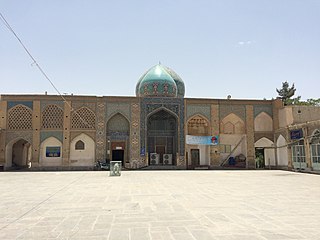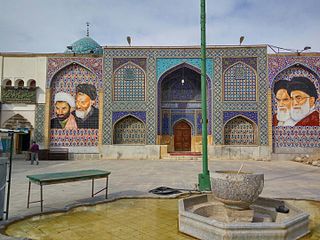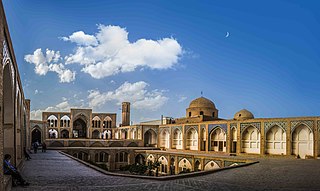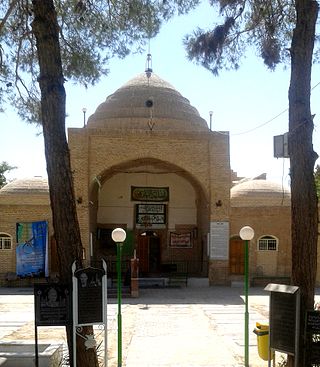
Qazvin province is one of the 31 provinces of Iran. It is in the northwest of the country, with the city of Qazvin as its capital.

An imamzadeh is a Persian term with two related meanings: a type of holy person in Shia Islam, and the shrine-tomb of such a person.

Damghan is a city in the Central District of Damghan County, Semnan province, Iran, serving as capital of both the county and the district.

Imamzadeh Darb-e Imam is a funerary complex located in the Dardasht quarter of Isfahan, Iran. It comprises two shrines, a mosque, and a mausoleum with royal cemetery. It is registered as number 217 on the list of Iran's national heritage monuments.
Tiran is a village in Ravar Rural District, in the Central District of Ravar County, Kerman Province, Iran. At the 2006 census, its population was 122, in 41 families.

The Imamzadeh Haroun-e-Velayat, or the Harun-i Vilayat Mausoleum, is an imamzadeh in Isfahan, Iran. It is located opposite the Ali minaret in Dardasht and belongs to the Ismail I era. There are many accounts of Harun Vilayat, the person who is buried in it. Some say that he is the seventh Imam's son and others, that he is the tenth Imam's son, but aside from the matter of who is buried in it, it is the most important historical structure related to the early Safavid era. Beyond the tomb it has also a portico, a tiled dome and a large yard.

Imamzadeh Ismail and Shayah Mosque is a historical funerary religious complex in Isfahan, Iran, which dates back to both the Seljuk and Safavid periods. This complex is number 112 on the list of Iran's national monuments, and it comprises the Imamzadeh Ismail and the Shayah Mosque.
Imamzadeh Ja'far is an imamzadeh in Isfahan, Iran. It is located opposite the Esmaeil religious complex. It is one of the pre-eminent structures of the Ilkhanid era. It is related that this emamzadeh is the grave of Ja'far ibn Abī Tālib, a companion of Mohammad. This structure was located formerly in the middle of a large yard, but it is now surrounded by residential buildings. The mausoleum is hexagonal and short and it seems that it had had a pyramid dome before, but its dome was destroyed and another dome like the dome of Chalabioghlou mausoleum in Soltaniyeh was built for it. This Emamzadeh is partly decorated by tiles.

Imamzadeh Ahmad is an imamzadeh in Isfahan, Iran. The Imamzadeh comprises a tomb, to the north and west of which are two iwans; the tomb faces a vast yard where several famous people, like Amir Kabir's daughter and Naser al-Din Shah's sister and wife, are buried. The emamzadeh himself was likely the Sultan Ali's son, who has been buried in Mashhad-e Ardehal.

Al-Rashid Mausoleum or Imamzadeh Husayn is a historical mausoleum in Isfahan, Iran. It dates back to the Seljukid era and is located on the northern bank of Zayanderud beside the Shahrestan bridge.

Takht-e Foulad, also known as Lissanul Arz is a historical cemetery in Isfahan, Iran. It is a large funerary complex that includes several historic mausoleums, mosques, tekyehs, sub-cemeteries and standalone graves.
The Meydan Mosque is a historical mosque in Kashan, Iran. It is located in the southern side of the Sang-e Ghadimi square and beside the Bazaar of Kashan. It is one of the oldest structures in Kashan. The primary structure belonged possibly to the seljuq era, but it was destroyed by the Mongols during their invasions. Later it was rebuilt and repaired by Khaje Emad ed-Din. A quotation for this matter is an inscription in the old mihrab, in which it is mentioned that it is built in 623 Hijri by Hassan ebn-e Arabschah in Kashan. The mihrab was in its original place until the last century, but it is kept now in the Museum of Islamic art in Berlin.

The Emamzadeh Ebrahim is a historical structure in Kashan, Iran. The Emamzadeh belongs to the Qajar era. It is well known for its turquoise dome, tiled minarets, pleasant yard and beautiful iwan. Paintings, tiles and decorations with cut mirrors have been added later in the early 20th century.
Emamzadeh Mir Neshaneh is the burial place of Hassan ibn-e Musa al-Kadhim, the Musa al-Kadhim's son. The emamzadeh has a conical turquoise dome. Its inner walls are decorated with tile mosaic. On the grave, there is a carved sepulcher, on the inscriptions of which it is written some verses of Koran. The wooden door of emamzadeh belongs to the 16th century. Beside the sepulcher, there is a basement, which is called Ghadamgah (footprint). In the basement, there is a water well. The walls and ceiling of the basement are decorated with colorful paintings. On the small door of the basement it is written the name Ganjali, which seems to be the bestower's name of the construction. The emamzadeh has also a mosque of the same name.

Emamzadeh Soltan Mir Ahmad is an Emamzadeh in Kashan, Iran. The tiling in front of the larger iwan and the two minarets of the building were repaired and rebuilt in the Qajar era. The emamzadeh includes a large courtyard, an iwan and a shrine. It has a conical dome and big porticoes.

The Khwaja Tajuddin Mausoleum, sometimes known as Khaje Taj od-Din Mausoleum is a historical religious complex located next to the Agha Bozorg Mosque in Fazel-e Naraghi district of Kashan, Iran. It was built in the 15th century over a Seljuk-era structure by the Timurid dignitary, Khwaja Zaynuddin, around the grave of his brother. It is number 400 on the list of Iran's national monuments.
The Emamzadeh Pir Davoud is an Imamzadeh in Ghamsar, Iran. It is said that it is the burial place of Davoud, Ali's grandson. The Imamzadeh is located in a pleasant and verdant spot in the north of Ghamsar adjacent to dense gardens. The structure was built in the Safavid era. The structure has a conical dome, which is decorated by turquoise tiles. The grave of the Imamzadeh is located in a wooden housing.

The Imamzadeh Hossein is the grave mosque of Imamazadeh Husayn, son of the 8th Imam Ali al-Rida in Qazvin, Iran that the Safavids - Shah Tahmasp I built in the mid-16th century as a pilgrimage center.

The Imamzadeh Yahya is the tomb of a sixth-generation descendant of Hasan ibn Ali. This Imamzadeh was built in southern Varamin, Iran during the Ilkhanate period between 1260 and 1310. It had multiple patrons including Fakhr al-Din, the local ruler of the Ray province when Varamin had been its capital. Fakhr al-Din was the protegé of the fourth Ilkhanate ruler Arghun Khan and invested heavily in the Imamzadeh, as he also shared heritage with Hasan ibn Ali. The tomb was constructed using extravagant, valuable materials and incorporates architectural elements that facilitate worship. Throughout the 19th and 20th centuries, tiles from the Imamzadeh Yahya were looted, and many are located today in museums around the world. Local residents and tourists pray at the site and use the courtyard as an event space.

The Tomb of Shaykh Haydar is located in the city of Meshginshahr, Iran. It was first built in the 14th century during the Ilkhanate period, and later served as a mausoleum for Shaykh Haydar, the father of Shah Ismail I. It is number 184 on the list of Iranian national heritage monuments.















